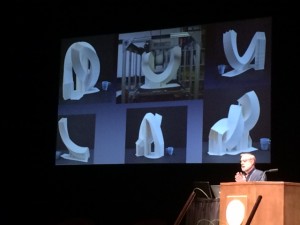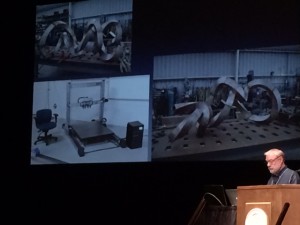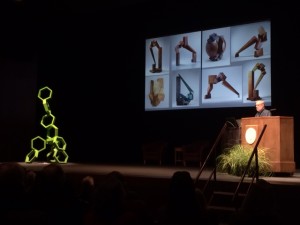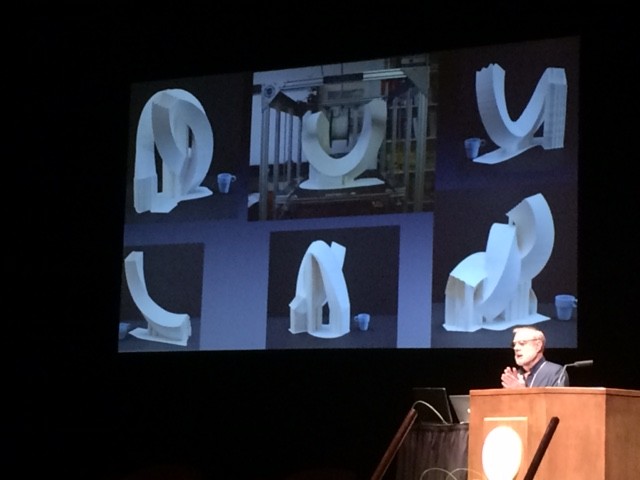Bruce Beasley and Author/


 sculptor Bridgette Mongeon have had several contacts in the last year. Bruce’s artwork adorns the cover of the book 3D Technology In Fine Art and Craft: Exploring 3D Printing, Scanning, Sculpting and Milling, and he is one of the many artists featured in the book. But the author’s impressions of this pioneer in 3D printing reach much deeper than just another artist in the book.
sculptor Bridgette Mongeon have had several contacts in the last year. Bruce’s artwork adorns the cover of the book 3D Technology In Fine Art and Craft: Exploring 3D Printing, Scanning, Sculpting and Milling, and he is one of the many artists featured in the book. But the author’s impressions of this pioneer in 3D printing reach much deeper than just another artist in the book.
“It is rare that you come upon an individual that is so genuine and whose presence and conversation makes you feel like you are old friends. Listening to them speak feels like sitting in front of a fire with a glass of wine sharing your deepest thoughts.” States Mongeon
That is also what the author felt as she sat at The Brown Symposium What Things May Come: 3D Printing in the Fine Arts and Sciences
February 26-27, 2015
Bruce was the keynote speaker and traveled with the audience through his 75 years to show his artwork and talk about his process. Below are some of Bridgette Mongeon’s notes from the warm interaction.
- “I’m not an artist that sees finished pieces in my head I need something to respond to. ”
Beasley, who works in large metal pieces, describes working on the computer as “free of material constraints.” - He talks about finding a gleam of an idea as if it is a heart beat. He follows it through the maze. Sometimes it leads to a sculpture and sometimes it peters out. His goal is not to make a great piece of art it is in the journey the exploration of shape. He looks for things that are endlessly interesting.
- He loves exploring shaped and says that he could not find an occupation that would allow him to explore shapes, so sculpture was the closest thing.
- As a young artists, he felt inadequate because he could not see his vision of something beforehand. “When I looked at a block of stone, I just saw a block of stone.” Once he mustered up the nerve to ask one of his favorite sculptors the question “do you see the shape?” He was comforted by the reply of “oh, no If I saw them in my head before I made them why would I make them?”
- Buying of his first commercial 3D printing machine was one of the most expensive things he has bought beside his studio.
- Lifelong quest of freedom of shape- “free myself from reality of material and gravity.”
He didn’t like how traditional process of bronze casting would deform his pieces. Nor did he like the nightmare of putting them together. Moving to a lost PLA of a 3D print solved the problem, but he longs for a water soluble support system that will easily wash away. - Bigger, better, faster, cheaper- That is what he longs for and sees as the downfalls of the 3D printing industry to date.
- He encourages artists to have a relationship with the pieces that you make. That is the deepest part of you. The relationship is the important part, and the sculpture is by product.
- He resented learning the computer interface, but it is what he has to do to get it to the exploration.
- A young girl from the floor of the symposium posed the question, If we create art on a machine is it manufactured or art? Bruce’s comments were insightful. ” No decisions are being made about my sculptures without me making them.” He describes it as just another tool
- When asked from a member of the audience what he thought about how colleges are doing away with the hands on things and replacing them with computer interaction Beasley thoughts were again insightful. There is a joy of using your body to create. He thinks everyone should get their hands dirty. It was the greatest epiphany for himself the head/heart/hands connection. It is a calling for many. In his creative life, ideas came from the interaction with these materials. When we are strictly working on the computer, he feels we tend to “intellectualize the art.”
- It does not matter what the material, each has its own voice.
- He mentioned he has a Gigabot 3D printer and uses Artworks Foundry In Berkeley to do his casting.
- As with many other artists who are pushing the technology to do what they want it to do, Bruce ended up inventing things along the way of creating art. He does not consider himself an inventor. He would prefer that he did not have to invent. He felt driven by an esthetic need. And Beasley feels that the inventing was driven by his tenacity.

